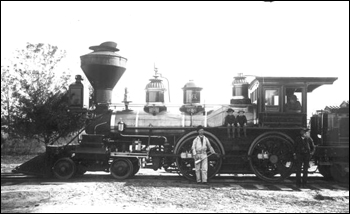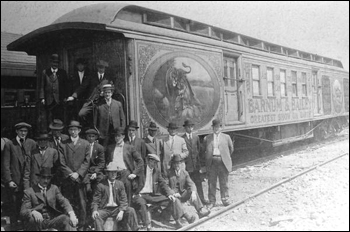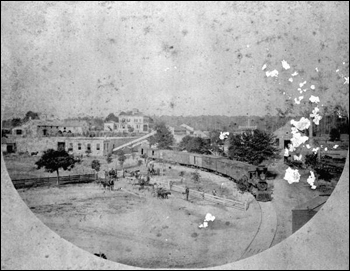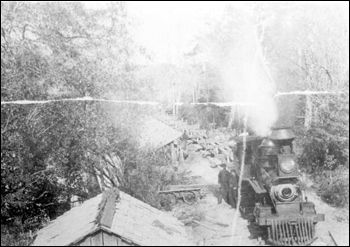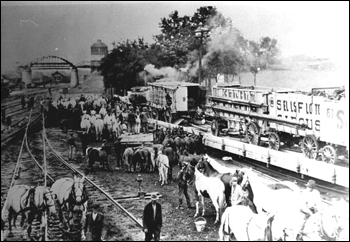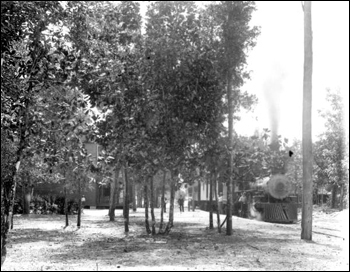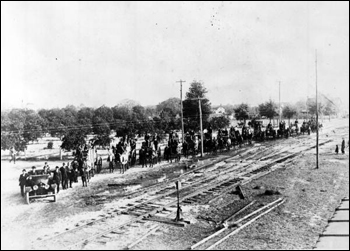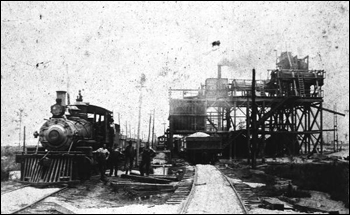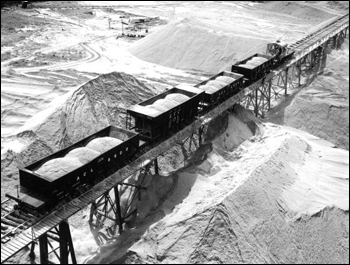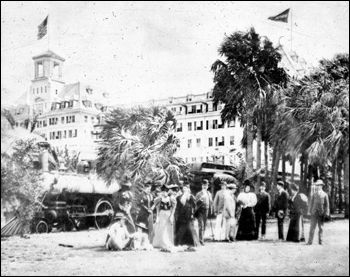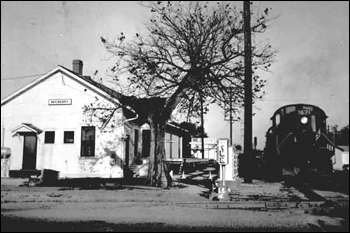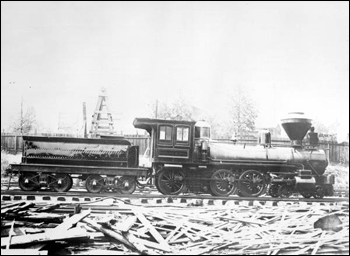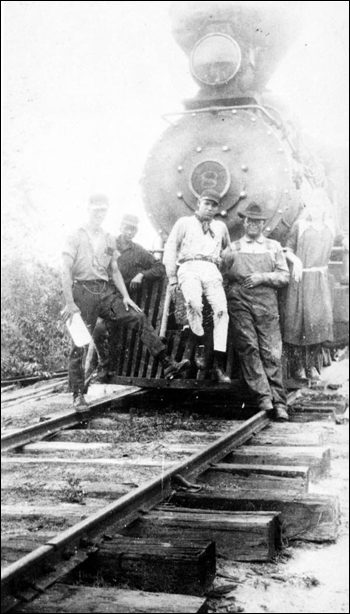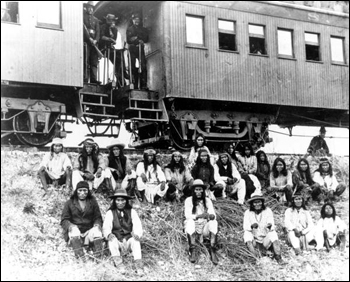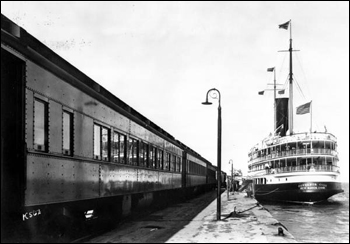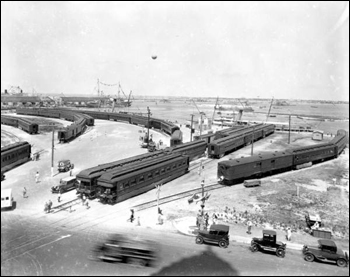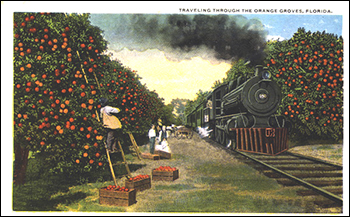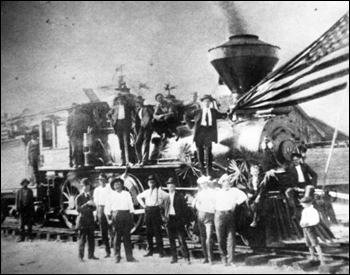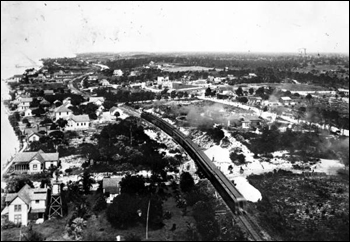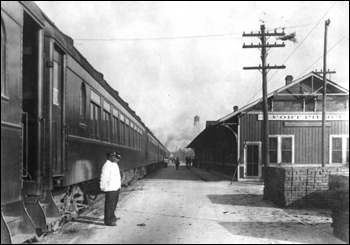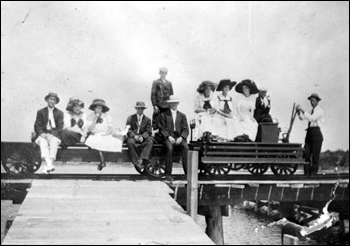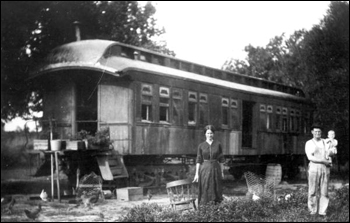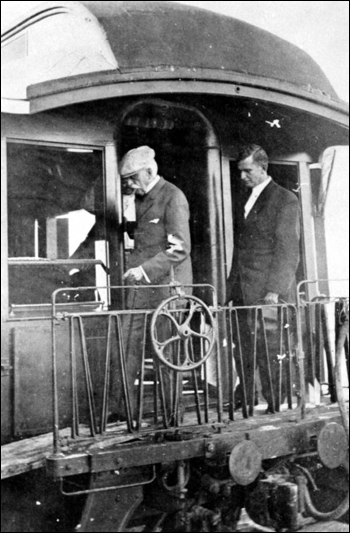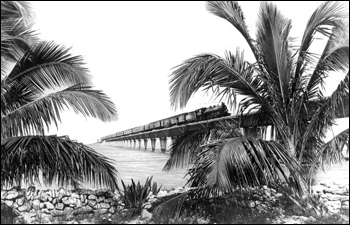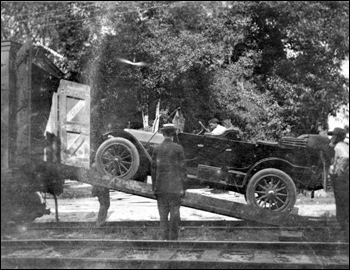Photo Exhibits
Photo exhibits spotlight various topics in Florida history, and are accompanied by brief text intended to place selected materials in historical context.
Tracks Toward the Future
Scenes from Florida’s Railroad History
Through Swamps and Sawgrass, Toward Modernity
Railroads opened Florida to new industry, expanded the tourist economy, and allowed for rapid development of residential and commercial areas. The first rail development authorized in Florida was the Tallahassee-St. Marks line, chartered in 1834. The first train to operate, however, was the Lake Wimico line that connected the boomtown of St. Joseph to the Apalachicola River in 1836. The Tallahassee-St. Marks train, which was initially mule-drawn, connected the highly productive cotton fields of Leon and Jefferson counties with the St. Marks River. These early efforts only hinted at the profound impact that railroads, passenger lines and freight trains would have on Florida's history.
Boys and crew posed with Florida Railway and Navigation Company engine number 16 (ca. 1886)
Image Number: HA00076
Men standing by Barnum & Bailey Circus railroad car (19__)
Image Number: FP82435a
View from cotton gin: Madison, Florida (188_)
Image Number: N046662
Looking East from Ingless cotton gin toward the Ingless home in the back center.
View from cotton gin: Madison, Florida (188_)
Image Number: RC11103
The logs floated to Skinner Manufacturing Company mill.
After statehood, community leaders and government leaders such as Senator David Yulee attempted to increase railway development in Florida. With state support, railroad developers began piece-meal projects to link East and West Florida, and Senator Yulee became the president of the Florida Railroad, completed in 1860, that connected the port cities of Fernandina on the northeast coast and Cedar Key on the Gulf. The Internal Improvement Act of 1855 granted companies large tracts of land in exchange for new tracks. New railway construction progressed slowly until the Civil War disrupted existing railway infrastructure.
Sells-Floto Circus train unloading (19__)
Image Number: FP82436i
Florida Railway and Navigation Company engine #15 at the Lanark Hotel (ca. 1885)
Image Number: HA00107
The hotel was located on the Gulf of Mexico in Franklin County, and was a summer retreat for Tallahasseeans and others.
All of railroads open in Florida at the time the Civil War began experienced varying degrees of decline and destruction during the war, as well as brief periods of prosperity due to military use. Portions of Yulee's Florida railroad were destroyed by Union attack, and Yulee worked with the Florida's Confederate government to temporarily remove tracks in strategic locations in order to prevent Union forces from quickly making their way into the state's interior by train. The Confederate government moved to seize existing rails to reuse the iron for new rail lines to transport troops and supplies. Despite some cooperation between railroad owners and the Confederate government, railroad operators such as Yulee met the state's efforts to take over lines with resistance-and even legal action. During the early years of Reconstruction, Florida corporations lacked the money to pay for projects started before the war, and the political and social disarray that dominated Southern life under martial law made it difficult to begin new railroad development.
Fifteen wagonloads of oranges: Umatilla, Florida (191_)
Image Number: N028998
Loading phosphate onto railroad car (1911)
Image Number: N032274
Located in the Bone Valley, a region of Central Florida primarily centered in the four counties of Hardee, Hillsborough, Manatee and Polk. The phosphate mined there is primarily used to produce fertilizer.
Bird’s-eye view showing phosphate being shipped by the Atlantic Coast Line railroad to the International Minerals Corporation factory for processing: Mulberry, Florida (1947)
Image Number: C005919
Accompanying note: "From field plant to factory for drying and final processing -- here phosphate is 14% moisture content, following process - less than 2%."
After the expansion of train lines during the 1880s-to Tampa and the West coast by Henry Plant and through Jacksonville and down the East coast by Henry Flagler-railroads connected Florida's developing industrial centers, luxury destinations, agricultural sectors and growing communities. That decade, railway mileage increased four-fold in the state. Though established 10 years earlier, the State Railroad Commission grew stronger in 1897 to better regulate passenger and freight rates and to correct transportation abuses.
Royal Poinciana guests standing beside the hotel train (1896)
Image Number: N036611
L-R: Col. Philip M. Lydig, Miss Helen Morton, Miss Gladys Vanderbilt, Miss Amy Townsend, Capt. A.T. Rose, Mrs. Cornelius Vanderbilt, Miss Edith Bishop, Miss Mabel Gerry, Thomas Cushing, Edward Livingston, Dudley Winthrop, Craig Wadsworth, Miss Gertrude Vanderbilt, Lispenard Stewart, Harry P. Whitney, Miss Sybil Sherman, Cornelius Vanderbilt.
Mulberry’s namesake tree (19__)
Image Number: N035648
When the railroad extended its line into the phosphate field, there was a point convenient to the four big phosphate plants (Palmetto Phosphate, Kingsford, Bone Valley and Land Pebble) in operation near a large mulberry tree. It became custom to stop the trains and unload freight near the tree, and shipments were often marked "put off at the big mulberry tree".
Gulf, Florida, and Alabama engine number 6 (1871)
Image Number: N038715
Originally owned by Pennsylvania Railroad as engine number 501; then owned by E.H. Wilson and Company in April, 1893; then owned by Cincinnati Portsmouth and Virginia as engine number 14; then owned by Norfork and Western as engine number 720, and later, number changed to 534; then owned by Southern Iron and Equipment Company as engine number 734; then owned by Gulf, Florida, and Alabama as engine number 6 in May 3, 1911.
Gulf, Florida, and Alabama Railroad Company engine number 8 (ca. 1920)
Image Number: N038597
Left to right: Victor Hutchins, conductor; Athon Hicks, fireman; Ivan Leonard, Engineer for Gulf, Florida and Alabama Railway Company, and E.W. Shaw, Engine 8's engineer; Louise Leonard, station agent. Falco was the end of the 26-mile line of the Gulf, Florida, and Alabama Railroad Company between Galliver, Fla. and Falco, Alabama. Engine 8 was used for Gulf, Florida, and Alabama Railroad Company and Louisville and Nashville's Pensacola and Atlantic Division line.
Geronimo and fellow Apache Indian prisoners on their way to Florida by train (1886)
Image Number: RC02773
Geronimo is on the front row, third from right.
Havanah Special met by the steamer Governor Cobb: Key West, Florida (192_)
Image Number: N038721
The history of railroads in Florida includes significant accomplishments of ambition and innovation including the construction of the Overseas Extension to the Florida East Coast Railway. Henry Flagler began the immense project in 1906 to connect Miami and mainland America-and his network of rails and hotels-to Key West. Construction of the extension entailed miles of bridges and large amounts of money, earth-moving and man-hours.
Bayside NE 11th Street: Miami, Florida (192_)
Image Number: N038736
Biscayne Boulevard in the foreground. MacArthur Causeway, Chalks Aviation, Flamingo Hotel, Miami harbor and blimp in the background.
Traveling through the orange groves: Florida (ca. 191_)
Image Number: PC0489
First train in Apalachicola (19__)
Image Number: PR09109
Florida East Coast Railway Company engine number 30: Fort Pierce, Florida (19__)
Image Number: N038573
Photograph taken from the water tank. Engine #30 was the northbound train; #29 was the southbound train. They were the "big events in town."
Florida East Coast Railway station: Fort Pierce (19__)
Image Number: PR00824
Small open motor train: Melbourne Beach, Florida (19__)
Image Number: PR09323
In addition to the large railroad systems, many "short rails" and specialized systems continued to operate in Florida. They reached rural communities and provided necessary rail transportation for industries such as timber and phosphate mining. In many locations, however, once the resources were gone, the trains soon disappeared.
Family using a railroad car of the Tavares and Gulf Railroad as a home: Tavares, Florida (ca. 191_)
Image Number: RC10646
Henry Flagler disembarking train at Key West (1912)
Image Number: PR09281
Flagler getting off train at Key West for official opening of extension to Key West.
Florida East Coast Railway train traveling along Overseas Extension bridge (19__)
Image Number: RC03742
Car being loaded onto a train at De Leon Springs for a trip to Buffalo, New York (1912)
Image Number: PR13139

 Listen: The Bluegrass & Old-Time Program
Listen: The Bluegrass & Old-Time Program